Yang Shen
Efficient Token Compression for Vision Transformer with Spatial Information Preserved
Mar 30, 2025



Abstract:Token compression is essential for reducing the computational and memory requirements of transformer models, enabling their deployment in resource-constrained environments. In this work, we propose an efficient and hardware-compatible token compression method called Prune and Merge. Our approach integrates token pruning and merging operations within transformer models to achieve layer-wise token compression. By introducing trainable merge and reconstruct matrices and utilizing shortcut connections, we efficiently merge tokens while preserving important information and enabling the restoration of pruned tokens. Additionally, we introduce a novel gradient-weighted attention scoring mechanism that computes token importance scores during the training phase, eliminating the need for separate computations during inference and enhancing compression efficiency. We also leverage gradient information to capture the global impact of tokens and automatically identify optimal compression structures. Extensive experiments on the ImageNet-1k and ADE20K datasets validate the effectiveness of our approach, achieving significant speed-ups with minimal accuracy degradation compared to state-of-the-art methods. For instance, on DeiT-Small, we achieve a 1.64$\times$ speed-up with only a 0.2\% drop in accuracy on ImageNet-1k. Moreover, by compressing segmenter models and comparing with existing methods, we demonstrate the superior performance of our approach in terms of efficiency and effectiveness. Code and models have been made available at https://github.com/NUST-Machine-Intelligence-Laboratory/prune_and_merge.
LatexBlend: Scaling Multi-concept Customized Generation with Latent Textual Blending
Mar 10, 2025Abstract:Customized text-to-image generation renders user-specified concepts into novel contexts based on textual prompts. Scaling the number of concepts in customized generation meets a broader demand for user creation, whereas existing methods face challenges with generation quality and computational efficiency. In this paper, we propose LaTexBlend, a novel framework for effectively and efficiently scaling multi-concept customized generation. The core idea of LaTexBlend is to represent single concepts and blend multiple concepts within a Latent Textual space, which is positioned after the text encoder and a linear projection. LaTexBlend customizes each concept individually, storing them in a concept bank with a compact representation of latent textual features that captures sufficient concept information to ensure high fidelity. At inference, concepts from the bank can be freely and seamlessly combined in the latent textual space, offering two key merits for multi-concept generation: 1) excellent scalability, and 2) significant reduction of denoising deviation, preserving coherent layouts. Extensive experiments demonstrate that LaTexBlend can flexibly integrate multiple customized concepts with harmonious structures and high subject fidelity, substantially outperforming baselines in both generation quality and computational efficiency. Our code will be publicly available.
Multi-Agent Coordination across Diverse Applications: A Survey
Feb 21, 2025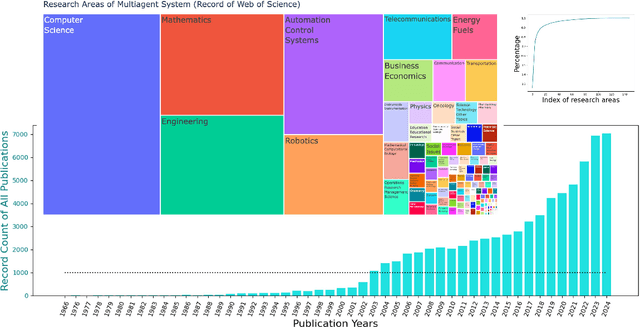
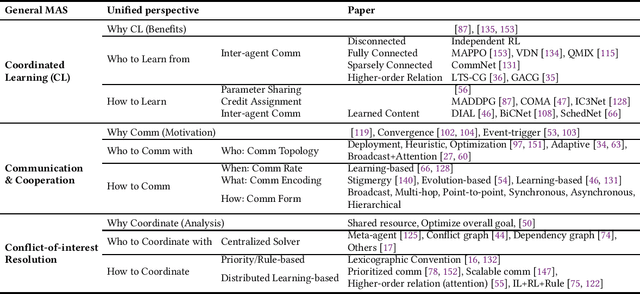
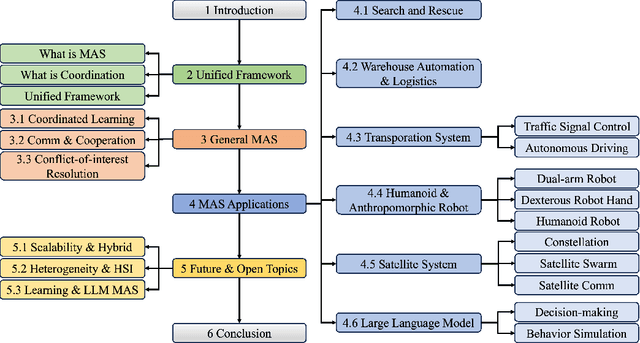
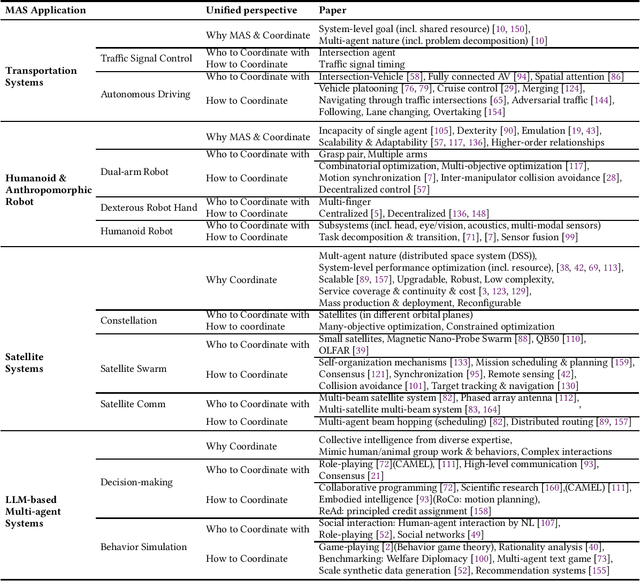
Abstract:Multi-agent coordination studies the underlying mechanism enabling the trending spread of diverse multi-agent systems (MAS) and has received increasing attention, driven by the expansion of emerging applications and rapid AI advances. This survey outlines the current state of coordination research across applications through a unified understanding that answers four fundamental coordination questions: (1) what is coordination; (2) why coordination; (3) who to coordinate with; and (4) how to coordinate. Our purpose is to explore existing ideas and expertise in coordination and their connections across diverse applications, while identifying and highlighting emerging and promising research directions. First, general coordination problems that are essential to varied applications are identified and analyzed. Second, a number of MAS applications are surveyed, ranging from widely studied domains, e.g., search and rescue, warehouse automation and logistics, and transportation systems, to emerging fields including humanoid and anthropomorphic robots, satellite systems, and large language models (LLMs). Finally, open challenges about the scalability, heterogeneity, and learning mechanisms of MAS are analyzed and discussed. In particular, we identify the hybridization of hierarchical and decentralized coordination, human-MAS coordination, and LLM-based MAS as promising future directions.
Explanatory Instructions: Towards Unified Vision Tasks Understanding and Zero-shot Generalization
Dec 25, 2024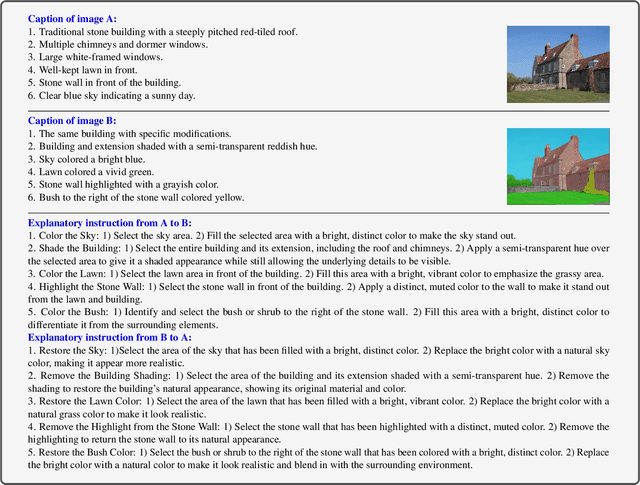
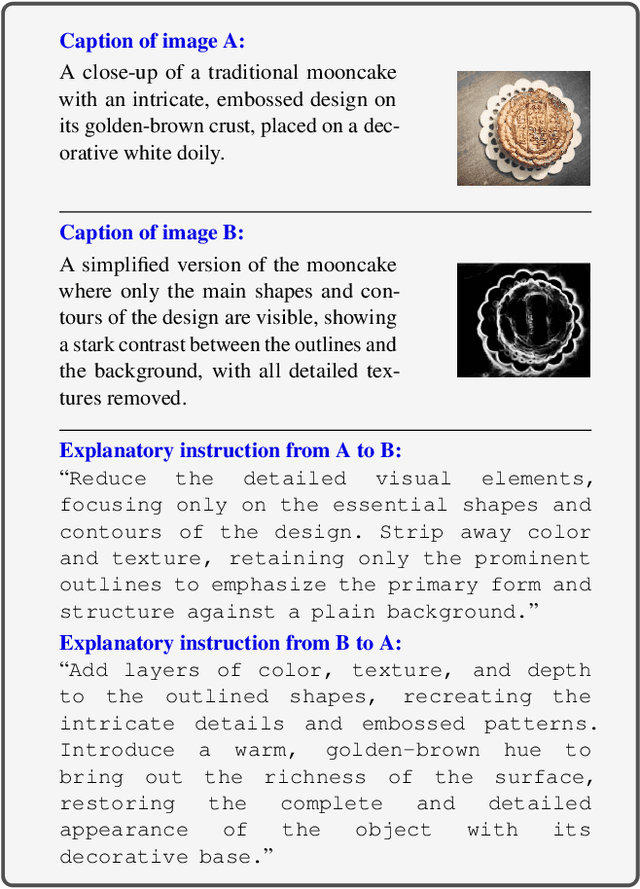

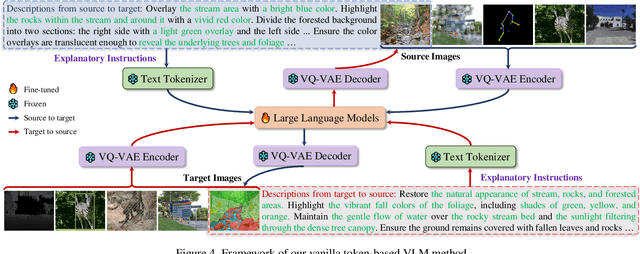
Abstract:Computer Vision (CV) has yet to fully achieve the zero-shot task generalization observed in Natural Language Processing (NLP), despite following many of the milestones established in NLP, such as large transformer models, extensive pre-training, and the auto-regression paradigm, among others. In this paper, we explore the idea that CV adopts discrete and terminological task definitions (\eg, ``image segmentation''), which may be a key barrier to zero-shot task generalization. Our hypothesis is that without truly understanding previously-seen tasks--due to these terminological definitions--deep models struggle to generalize to novel tasks. To verify this, we introduce Explanatory Instructions, which provide an intuitive way to define CV task objectives through detailed linguistic transformations from input images to outputs. We create a large-scale dataset comprising 12 million ``image input $\to$ explanatory instruction $\to$ output'' triplets, and train an auto-regressive-based vision-language model (AR-based VLM) that takes both images and explanatory instructions as input. By learning to follow these instructions, the AR-based VLM achieves instruction-level zero-shot capabilities for previously-seen tasks and demonstrates strong zero-shot generalization for unseen CV tasks. Code and dataset will be openly available on our GitHub repository.
The Key of Understanding Vision Tasks: Explanatory Instructions
Dec 24, 2024



Abstract:Computer Vision (CV) has yet to fully achieve the zero-shot task generalization observed in Natural Language Processing (NLP), despite following many of the milestones established in NLP, such as large transformer models, extensive pre-training, and the auto-regression paradigm, among others. In this paper, we explore the idea that CV adopts discrete and terminological task definitions (\eg, ``image segmentation''), which may be a key barrier to zero-shot task generalization. Our hypothesis is that without truly understanding previously-seen tasks--due to these terminological definitions--deep models struggle to generalize to novel tasks. To verify this, we introduce Explanatory Instructions, which provide an intuitive way to define CV task objectives through detailed linguistic transformations from input images to outputs. We create a large-scale dataset comprising 12 million ``image input $\to$ explanatory instruction $\to$ output'' triplets, and train an auto-regressive-based vision-language model (AR-based VLM) that takes both images and explanatory instructions as input. By learning to follow these instructions, the AR-based VLM achieves instruction-level zero-shot capabilities for previously-seen tasks and demonstrates strong zero-shot generalization for unseen CV tasks. Code and dataset will be openly available on our GitHub repository.
Customized Generation Reimagined: Fidelity and Editability Harmonized
Dec 06, 2024Abstract:Customized generation aims to incorporate a novel concept into a pre-trained text-to-image model, enabling new generations of the concept in novel contexts guided by textual prompts. However, customized generation suffers from an inherent trade-off between concept fidelity and editability, i.e., between precisely modeling the concept and faithfully adhering to the prompts. Previous methods reluctantly seek a compromise and struggle to achieve both high concept fidelity and ideal prompt alignment simultaneously. In this paper, we propose a Divide, Conquer, then Integrate (DCI) framework, which performs a surgical adjustment in the early stage of denoising to liberate the fine-tuned model from the fidelity-editability trade-off at inference. The two conflicting components in the trade-off are decoupled and individually conquered by two collaborative branches, which are then selectively integrated to preserve high concept fidelity while achieving faithful prompt adherence. To obtain a better fine-tuned model, we introduce an Image-specific Context Optimization} (ICO) strategy for model customization. ICO replaces manual prompt templates with learnable image-specific contexts, providing an adaptive and precise fine-tuning direction to promote the overall performance. Extensive experiments demonstrate the effectiveness of our method in reconciling the fidelity-editability trade-off.
V2X-Radar: A Multi-modal Dataset with 4D Radar for Cooperative Perception
Nov 17, 2024
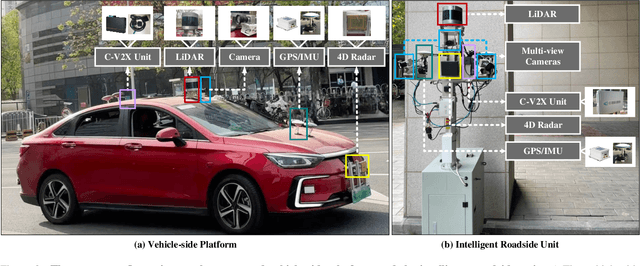


Abstract:Modern autonomous vehicle perception systems often struggle with occlusions and limited perception range. Previous studies have demonstrated the effectiveness of cooperative perception in extending the perception range and overcoming occlusions, thereby improving the safety of autonomous driving. In recent years, a series of cooperative perception datasets have emerged. However, these datasets only focus on camera and LiDAR, overlooking 4D Radar, a sensor employed in single-vehicle autonomous driving for robust perception in adverse weather conditions. In this paper, to bridge the gap of missing 4D Radar datasets in cooperative perception, we present V2X-Radar, the first large real-world multi-modal dataset featuring 4D Radar. Our V2X-Radar dataset is collected using a connected vehicle platform and an intelligent roadside unit equipped with 4D Radar, LiDAR, and multi-view cameras. The collected data includes sunny and rainy weather conditions, spanning daytime, dusk, and nighttime, as well as typical challenging scenarios. The dataset comprises 20K LiDAR frames, 40K camera images, and 20K 4D Radar data, with 350K annotated bounding boxes across five categories. To facilitate diverse research domains, we establish V2X-Radar-C for cooperative perception, V2X-Radar-I for roadside perception, and V2X-Radar-V for single-vehicle perception. We further provide comprehensive benchmarks of recent perception algorithms on the above three sub-datasets. The dataset and benchmark codebase will be available at \url{http://openmpd.com/column/V2X-Radar}.
Equivariant Blurring Diffusion for Hierarchical Molecular Conformer Generation
Oct 26, 2024



Abstract:How can diffusion models process 3D geometries in a coarse-to-fine manner, akin to our multiscale view of the world? In this paper, we address the question by focusing on a fundamental biochemical problem of generating 3D molecular conformers conditioned on molecular graphs in a multiscale manner. Our approach consists of two hierarchical stages: i) generation of coarse-grained fragment-level 3D structure from the molecular graph, and ii) generation of fine atomic details from the coarse-grained approximated structure while allowing the latter to be adjusted simultaneously. For the challenging second stage, which demands preserving coarse-grained information while ensuring SE(3) equivariance, we introduce a novel generative model termed Equivariant Blurring Diffusion (EBD), which defines a forward process that moves towards the fragment-level coarse-grained structure by blurring the fine atomic details of conformers, and a reverse process that performs the opposite operation using equivariant networks. We demonstrate the effectiveness of EBD by geometric and chemical comparison to state-of-the-art denoising diffusion models on a benchmark of drug-like molecules. Ablation studies draw insights on the design of EBD by thoroughly analyzing its architecture, which includes the design of the loss function and the data corruption process. Codes are released at https://github.com/Shen-Lab/EBD .
Correlational Lagrangian Schrödinger Bridge: Learning Dynamics with Population-Level Regularization
Feb 04, 2024Abstract:Accurate modeling of system dynamics holds intriguing potential in broad scientific fields including cytodynamics and fluid mechanics. This task often presents significant challenges when (i) observations are limited to cross-sectional samples (where individual trajectories are inaccessible for learning), and moreover, (ii) the behaviors of individual particles are heterogeneous (especially in biological systems due to biodiversity). To address them, we introduce a novel framework dubbed correlational Lagrangian Schr\"odinger bridge (CLSB), aiming to seek for the evolution "bridging" among cross-sectional observations, while regularized for the minimal population "cost". In contrast to prior methods relying on \textit{individual}-level regularizers for all particles \textit{homogeneously} (e.g. restraining individual motions), CLSB operates at the population level admitting the heterogeneity nature, resulting in a more generalizable modeling in practice. To this end, our contributions include (1) a new class of population regularizers capturing the temporal variations in multivariate relations, with the tractable formulation derived, (2) three domain-informed instantiations based on genetic co-expression stability, and (3) an integration of population regularizers into data-driven generative models as constrained optimization, and a numerical solution, with further extension to conditional generative models. Empirically, we demonstrate the superiority of CLSB in single-cell sequencing data analyses such as simulating cell development over time and predicting cellular responses to drugs of varied doses.
Towards Scenario Generalization for Vision-based Roadside 3D Object Detection
Jan 29, 2024



Abstract:Roadside perception can greatly increase the safety of autonomous vehicles by extending their perception ability beyond the visual range and addressing blind spots. However, current state-of-the-art vision-based roadside detection methods possess high accuracy on labeled scenes but have inferior performance on new scenes. This is because roadside cameras remain stationary after installation and can only collect data from a single scene, resulting in the algorithm overfitting these roadside backgrounds and camera poses. To address this issue, in this paper, we propose an innovative Scenario Generalization Framework for Vision-based Roadside 3D Object Detection, dubbed SGV3D. Specifically, we employ a Background-suppressed Module (BSM) to mitigate background overfitting in vision-centric pipelines by attenuating background features during the 2D to bird's-eye-view projection. Furthermore, by introducing the Semi-supervised Data Generation Pipeline (SSDG) using unlabeled images from new scenes, diverse instance foregrounds with varying camera poses are generated, addressing the risk of overfitting specific camera poses. We evaluate our method on two large-scale roadside benchmarks. Our method surpasses all previous methods by a significant margin in new scenes, including +42.57% for vehicle, +5.87% for pedestrian, and +14.89% for cyclist compared to BEVHeight on the DAIR-V2X-I heterologous benchmark. On the larger-scale Rope3D heterologous benchmark, we achieve notable gains of 14.48% for car and 12.41% for large vehicle. We aspire to contribute insights on the exploration of roadside perception techniques, emphasizing their capability for scenario generalization. The code will be available at {\url{ https://github.com/yanglei18/SGV3D}}
 Add to Chrome
Add to Chrome Add to Firefox
Add to Firefox Add to Edge
Add to Edge